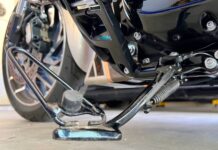
If you’ve done any research on how batteries work, types of batteries or what specs you should look for in a battery, you’re probably buried in information… even confused. Personally, I just hate ’em all. A battery is either the most treacherous thing you put your trust in or the most trustworthy thing you know to be treacherous. Thing is, these days they are absolutely inescapable… no different than death or taxes. So I reckon this sort of boils down to “know thy enemy” self-defense stuff. (A personal note: of my fleet of eight machines only one relies on the old-fashioned magneto… thus possibly my only means of escape from the EMP wars or the zombie apocalypse.) That said, I too must deal with the dreaded juice box… so perhaps you can forgive me for using the KISS (Keep It Simple, Stupid) method (wherever possible) as we go on.
The attempt is to explain how lead acid batteries work and what they need, without burying you with a bunch of needless technical data. I have found that battery data will vary somewhat from manufacturer to manufacturer, so I will do my best to boil that data down. This means I may generalize a bit, while staying true to purpose.
The lead acid battery has been used commercially for over 100 years. Meaning this stuff ain’t news… it’s the same chemical principle that’s been used to store energy, since our great-grandparents’ day.
Present-day battery power requirements are huge because of modern chassis electronics, starting with EFI! All the electronics require a reliable power source; all those added-on electrical gadgets require even more… and a marginal battery doesn’t bode well for electronic component reliability. It wasn’t always so. When Harleys had points ignitions, basic lighting, a horn and a kickstarter… well, batteries weren’t great back then, but they had an easier life. In spite of notable technological improvements over the last decade or so, average battery life hasn’t improved that much and statistically even become slightly shorter (only 30 percent of all motorcycle batteries actually live 48 months or more) as energy requirements have increased. That life span depends on usage… spelled “you”-sage! Fact is, we kill batteries more often than they die a natural death, because they are so “out of sight, out of mind” for most of us. So, please hold this thought, above all else… a battery is like a bank account. If you keep taking out and putting nothing back, you won’t have anything left. But, once equipped with a grasp of the basics, you’ll have fewer battery problems and will gain greater battery performance, reliability and longevity. In other words…you can profit by knowing the dry facts about wet cells.


Types
Any lead acid battery is made up of plates, lead, and lead oxide (various other elements are used to change density, hardness, porosity, etc.), with a 35-percent sulfuric acid and 65-percent water solution. This “electrolyte” solution causes a chemical reaction that produces…(Duh!)… electrons. When you test a battery with a hydrometer, you’re measuring the amount of sulfuric acid in the electrolyte. If your reading is low, that means electrolyte is turning to water. So where did the sulfur go? It’s resting on the battery plates so that when you recharge the battery, the sulfur returns to the electrolyte… but only X number of times… and once it stays permanently it has battery “cancer” a.k.a. “sulfation.”
Flooded wet cell, gel cell, and absorbed glass mat (AGM) are all versions of the lead acid battery. Some actually prefer to routinely add water and check the specific gravity of the electrolyte with a hydrometer. I… and most of you… prefer the latter. Kickstart Sportsters and electric-start Pans and Shovels are mostly stuck using old-school “flooded” batteries… complete with filler caps and overflow hoses (puke tubes)… but as we’ll learn later… they don’t have to.
AGM batteries are “modern” batteries that store very well and don’t sulfate or degrade nearly as easily as a conventional wet cell and they are the safest lead acid batteries because there’s little chance of a hydrogen gas explosion or corrosion. Absorbed glass matt construction allows the electrolyte to be suspended in close proximity with the plates, enhancing both the discharge and recharge efficiency. (AGM batteries can be discharged to as much as 60 percent, yet come back to life for as often as 300-plus cycles.) Since AGM batteries hold their charge better than other types, they are the dominant type installed in Harleys today… for “seasonal” usage… ya know?
For the record—Yuasa introduced AGM batteries to the motorcycle market in 1983 with the YT series. The first design upgrade was in 1988 with the YTX series which has become the de facto standard by which all others are measured. Next… in 1999… came the YTZ series that were the first “factory-activated” AGM batteries… so buyers need not screw around with adding electrolyte themselves. YTZ batteries are big power in a small battery, mostly used for multi-cylinder sportbikes. Along the way, the YIX series was developed for big power in big-displacement bikes. (Remember those huge old car-sized “tar-top” batteries from the electric-start Pan/Shovel era? The YIX battery in modern baggers is 2/3 the size and has nearly double the potency!) In 2008, the latest design, GYZ series, became the most powerful and toughest AGM battery design to date.

It’s all too common to use the term “gel cell” as a generic term when referring to any sealed, maintenance-free battery. The gel-cell battery is similar to the AGM (in that the electrolyte is suspended) yet different, because technically, the AGM battery is still a wet cell. Electrolyte in a gel cell has a silica additive that causes it to set up or “stiffen.” Sealed gel cell VRLA (Valve Regulated Lead Acid) deep-cycle batteries also use GRT (Gas Recombinant Technology) invented in 1934 by Otto Jache and commercially introduced by Sonnenschein in 1957. Gel cell batteries have most of the same advantages and disadvantages of AGM VRLA batteries and use lead with calcium alloy for both positive and negative plate formulations. Compared with gel cell flat plate and spiral wound AGM batteries (like Odyssey) gel cells will typically:
• Cost more due to the expense of manufacture
• Need a 10-15 cycle “break-in” period
• Have only 80 percent of the capacity of a similar-sized AGM (Ca/Ca) battery with fewer cold cranking amps… but provide up to 20 percent more cycles than AGM VRLA batteries
• Have greater ability to withstand a deeper discharge, but not in temperatures over 100°F because of the possibility of “thermal runaway”
• Require longer re-charging times at lower currents because they’re intolerant of incorrect charging voltages which require special gel cell chargers or gel cell settings. (If the wrong battery charger is used on a gel cell battery, poor performance and premature failure is… certain.)
Gel batteries are best used in deep-cycle applications, rather than as a starter battery for motorcycles, but they last a bit longer in hot weather… so some folks still prefer them for that reason. All battery types are “graded” by these… standards:
• Cold cranking amps (CCA), the most commonly known battery “measurement” is, in reality, simply a close estimate (based on industry “values”) of the number of amps a battery can deliver at 0°F for 30 seconds and not drop below 7.2 volts. Not a lot of worry about that with Harley riders, but cars get used all winter, so CCA rating (as irrelevant as it really is for motorcycles) has become the yardstick for battery performance.
• (CA) is cranking amps measured at 32°F. Probably more relevant to us, but rarely revealed these days.
• Hot cranking amps (HCA) is seldom used any longer either, but is measured at 80°F. This… should be the main measurement for motorcycle batteries for reasons we’ll get to.
• Reserve Capacity (RC) is a very important rating. This is the number of minutes a fully charged battery at 80°F will discharge 25 amps before the battery drops below 10.5 volts.
• Amp hours (Ah) is unit of measurement which quantifies the amount of current flow for an amount of time. For example, a current of 1 amp drawn from a battery for 10 hours would consume 10 amp hours of charge from the battery. Fundamentally, a measurement of electrical charge. Critical info for boats and RVs and such… but for us, probably most useful for baggers with lots of electronic…ah… baggage!
We’ve yet to deal with lithium ion battery design! We will… along with maintenance (and maintainers)… in the next installment of this treatise.


















